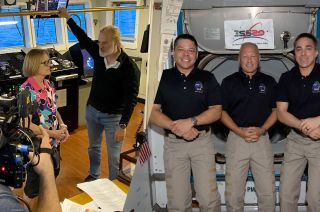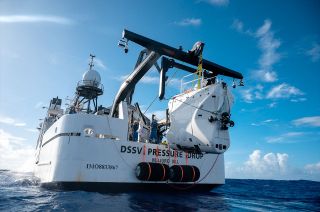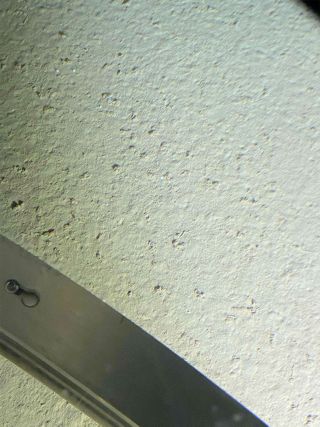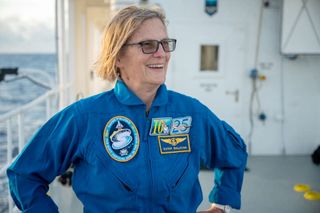Astronaut-aquanaut connects with space station after deep sea dive

When astronauts aboard the International Space Station call down to Earth, they refer to it as "space to ground."
For a call they made on June 7, however, a slightly different term was merited.
"This is Chris Cassidy, Bob Behnken and Doug Hurley on the International Space Station, wonderful to hear you and connect from space to the surface," the NASA astronauts radioed to the DSSV Pressure Drop, the support ship for the world's first and only commercially-certified, full-ocean-depth deep submergence vehicle, or DSV.
"It's great to connect with you," replied Kathy Sullivan, who only hours earlier had returned from diving to Challenger Deep, the deepest point on Earth. "Victor Vescovo, the pilot of the [DSV] Limiting Factor, and I are back on the surface ship at this point."
Related: Astronaut-aquanauts: 50 people who orbited Earth & lived undersea

"Kathy is the first astronaut to go down to the bottom of the ocean," Vescovo said, "and the first woman. So we're very proud of her."
On June 6, Sullivan became the eighth person and first woman to reach the very bottom of the Mariana Trench, a depression nearly 7 miles (11 kilometers) down in the Western Pacific Ocean called "Challenger Deep." Thirty-six years earlier, during the first of her three space missions as a NASA astronaut, Sullivan became the first American woman to walk in space.
Get the Space.com Newsletter
Breaking space news, the latest updates on rocket launches, skywatching events and more!
"Looked a little more like the moonscape than anything I've seen on this planet so far," Sullivan said, describing the deep sea floor to the three NASA astronauts orbiting 250 miles (400 km) above Earth. "We spent about an hour and a half on the bottom [and] rendezvoused with one of our autonomous landers."

"That's outstanding Kathy, congratulations, what a great accomplishment," said Cassidy, the commander of the space station's Expedition 63 crew and a former U.S. Navy SEAL. In 2009, on his first mission, Cassidy became the 500th person to launch into space.
Cassidy's two American crewmates, Hurley and Behnken, made history of their own by becoming the first U.S. astronauts to launch on a commercial rocket and spacecraft. The two arrived at the space station aboard SpaceX's Crew Dragon capsule on May 31.
"Like your ride, Doug and Bob, the SpaceX vehicle, [the Limiting Factor] was designed to be reusable. It is the only craft that's been down to the Challenger Deep more than once," said Vescovo. "So congratulations on your incredible journey on the Dragon."
"Thank you for that, Victor," replied Behnken. "Doug and I are really excited for our mission as a first, but the chance to have the vehicle reused three, four and multiple times is an outstanding accomplishment, one that the SpaceX team hopes to accomplish as well."
The Crew Dragon capsule was designed by SpaceX to launch into orbit five times.
At the time of the space-to-sea call, the Limiting Factor had been down to Challenger Deep four times over the course of two expeditions in 2019 and 2020. As of Sunday (June 21), it had made three more descents, including dives with Vanessa O'Brien, who also summited Mount Everest, and Kelly Walsh, the son of Don Walsh, one of the first two people to reach Challenger Deep in 1960.
"The number of people who have dived to the deepest point in the ocean finally equals the number who have walked on the moon — 12. It only took 51 years," said Sullivan in a later social media post.
Vescovo joked with Behnken and Hurley that SpaceX CEO Elon Musk could add to that number.
"Definitely tell your boss if he gives me a ride in his, I'll give him a ride in mine," said Vescovo, who underwrote the build of the multi-million dollar Limiting Factor by Triton Submarines and financed the current dives led by EYOS Expeditions and his own Caladan Oceanic.
"Yeah, just like you alluded to, it's above our pay grade who gets a ride," replied Behnken.
Sullivan also likened her submersible ride to a trip on a rocket ship.
"It's like having a craft that can make daily trips to the moon considering how exotic and impossible it has been in all of history up until now to get to Challenger Deep," she said.
More than just a sightseeing voyage, Sullivan and Vescovo's dive was part of a series of scientific excursions to survey Challenger Deep and map the U.S. Exclusive Economic Zone at the request of the National Oceanic and Atmospheric Administration (NOAA), the federal agency that Sullivan previously led as its 10th administrator from 2014 to 2017.
"Congratulations on your scientific accomplishments in the deep underwater as we're trying to accomplish the same on the International Space Station," said Behnken. "Doug and I were able to arrive up here and add, I guess, maybe two working, helping hands between the two of us to Chris' helping hands to keep the space station operating, both to accomplish science, but also to support us on board."

Sullivan extended the similarities between her astronaut experience and her achievement as an aquanaut by having a mission patch for her dive (featuring the tagline, "The Most Vertical Girl in the World"). She was also the first person to wear a badge to signify having reached "10+ km" deep that space patch artist Tim Gagnon styled after NASA's "Mach 25" emblems awarded to astronauts after they return from Earth orbit.
Though rare, Sullivan's call was not the first astronauts to astronaut-aquanaut call.
In 1965, Gemini 5 crewmates Gordon Cooper and Pete Conrad briefly spoke with Mercury astronaut Scott Carpenter, who at the time was aboard the U.S. Navy's SEALAB II experimental underwater habitat, 205 feet (62 m) down off the coast of southern California. Four decades later, astronauts on board the International Space Station connected with astronaut-aquanauts conducting a NEEMO (NASA Extreme Environment Mission Operations) mission on the Aquarius undersea lab 62 feet (18 m) below the surface off the coast of Florida.
Sullivan and the Expedition 63 crew members concluded their own long distance call with an agreement to meet in the future to further discuss their experiences.
"Maybe someday we can meet and talk about it someplace in the middle of the deep sea or [on] the International Space Station in low Earth orbit," said Behnken.
"That's a deal!" said Sullivan. "I'll buy the first beer, you buy the second.”
Click through to collectSPACE to hear the call between astronaut-aquanaut Kathy Sullivan and the space station.
- Astronauts are heading under the sea to test moon mission tech
- 'Aquanauts' complete mock asteroid mission on ocean floor
- Photos: Underwater astronauts practice space exploration on ocean floor
Follow collectSPACE.com on Facebook and on Twitter at @collectSPACE. Copyright 2020 collectSPACE.com. All rights reserved.
OFFER: Save 45% on 'All About Space' 'How it Works' and 'All About History'!
For a limited time, you can take out a digital subscription to any of our best-selling science magazines for just $2.38 per month, or 45% off the standard price for the first three months.
Join our Space Forums to keep talking space on the latest missions, night sky and more! And if you have a news tip, correction or comment, let us know at: community@space.com.

Robert Pearlman is a space historian, journalist and the founder and editor of collectSPACE.com, an online publication and community devoted to space history with a particular focus on how and where space exploration intersects with pop culture. Pearlman is also a contributing writer for Space.com and co-author of "Space Stations: The Art, Science, and Reality of Working in Space” published by Smithsonian Books in 2018. He previously developed online content for the National Space Society and Apollo 11 moonwalker Buzz Aldrin, helped establish the space tourism company Space Adventures and currently serves on the History Committee of the American Astronautical Society, the advisory committee for The Mars Generation and leadership board of For All Moonkind. In 2009, he was inducted into the U.S. Space Camp Hall of Fame in Huntsville, Alabama. In 2021, he was honored by the American Astronautical Society with the Ordway Award for Sustained Excellence in Spaceflight History.


